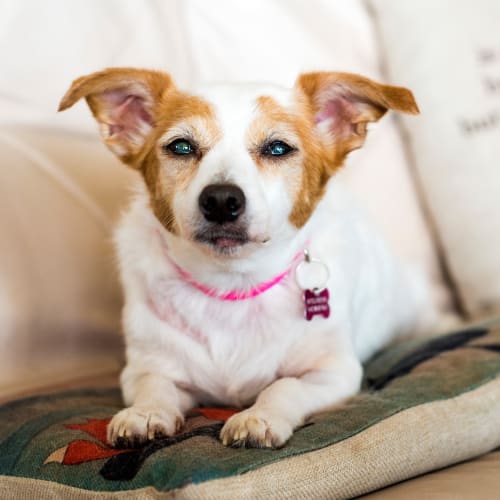What are cataracts?
Each dog’s eye has a lens which is used to focus vision. When a cataract develops there is an opacification or cloudiness which affects all or part of the lens, preventing a clear image from being focused on the retina and interfering with the dog's ability to see clearly.
Cataracts in dogs are most often an inherited condition. Poodles, American cocker spaniels, miniature schnauzers, and Boston terriers tend to be at higher risk of developing cataracts.
That said, cataracts may also develop in dogs as a result a metabolic disease such as diabetes, inflammation in the eye, retinal disease or ocular trauma. This condition is most often seen in older dogs because cataracts tend to be relatively slow to form.

How are cataracts diagnosed in dogs?
If you notice that your dog's eyes appear cloudy, or if you suspect that your dog is having vision trouble see your vet for an eye examination. Your vet may refer you to a Veterinary Ophthalmic Specialist (eye specialist for pets) who will be able to run tests to confirm the diagnosis, and recommend appropriate treatment for your dog.
What treatments are available for cataracts in dogs?
Cataracts cannot be reversed however, in some cases they can be surgically removed in order to restore vision. Unfortunately, not all dogs with cataracts are good candidates for surgery however early detection of cataracts can help to save your dog's eyesight. Visiting your vet regularly for wellness exams gives your vet the opportunity to check your dog's eyes for signs of developing cataracts and recommend treatment before they become more serious.
What is the cataract surgery process for dogs?
When your dog is going in for cataract surgery you will usually drop your dog off at the vet's office either the night before the surgery, or the morning of the procedure.
Before heading into surgery your dog will be sedated and an ultrasound will be performed in order to check for problems such as retinal detachment or rupture (bursting) of the lens. Next, an electroretinogram (ERG) will be done to confirm that your dog's retina is working properly. Your dog may not be suitable for cataract surgery if these preliminary tests turn up any unexpected issues.
When the procedure begins, the cataract will be removed using a technique called phacoemulsification. Phacoemulsification utilizes an ultrasonic device to break up and remove the cloudy lens from your dog's eye. This is the same method that it used in cataract surgery on people. In most cases, once the cloudy lens has been removed an artificial lens designed for dogs will be placed where the old lens had been.
Following surgery your veterinary specialist may recommend that your dog stay in hospital overnight for monitoring. In some cases dogs experience increased vision the very next day, but it typically takes a few weeks for vision to settle once the eye adjusts to the effect of surgery and the presence of the new artificial lens.
After your dog's cataract surgery, intensive aftercare will be required. Aftercare will include the use several types of eye drops, multiple times a day, for an extended period of time. Your vet will provide you with detailed instructions on how to care for your dog's eyes following cataract surgery. In order to give your dog the best possible chance of regaining clear vision it's important to follow your vet's instructions carefully.
After cataract surgery how well will my dog be able to see?
If the rest of your dog's eye is in good working order, cataract surgery is considered to be a very successful treatment with a high rate of positive outcomes. As much as 95% of dogs regain vision as soon as they recover from the surgery. If surgery is successful and your dog regains their vision, the long-term prognosis for your dog maintaining vision is about 90% at 1 year, and 80% at 2 years after the surgery.
Good post-operative care and regular visits to the vet for examinations and monitoring are key to successful long-term outcomes.
What is the recovery time for cataract surgery in dogs?
The initial healing period following cataract surgery in dogs is about 2 weeks. Throughout that period, your dog will need to wear a cone or E-collar at all times and have their activity restricted to leash walks only. Several medications will also need to be administered to your dog during their recovery, including eye drops and oral medications.
At your dog's 2 week follow-up appointment medications may be reduced, however some dogs need to remain on medication long-term.
